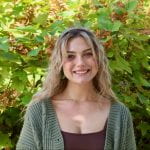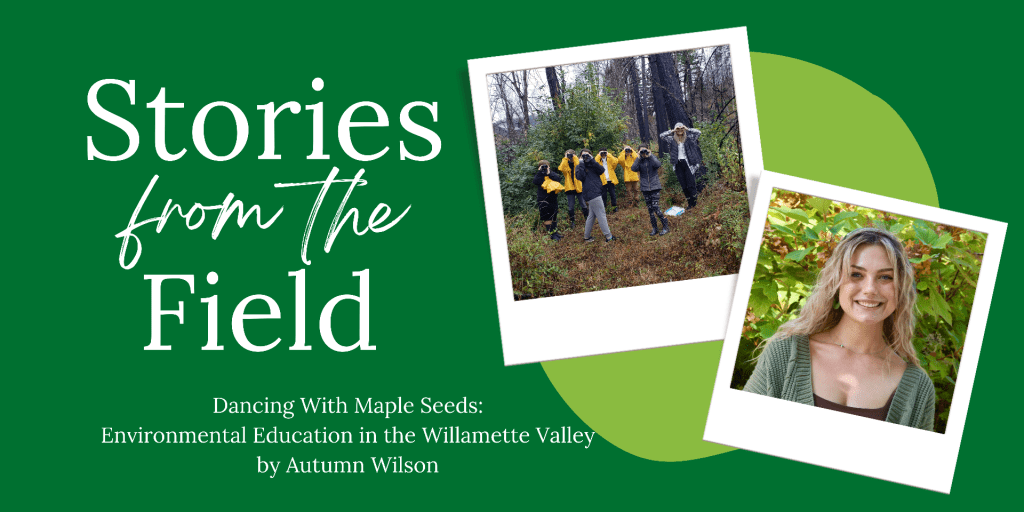by Autumn Wilson, Youth Education Project Lead, Middle Fork Willamette Watershed Council
It started with the wind. A sudden burst of warmth that cut through the dense, frigid November air like a long-awaited reprieve. The five tiny humans that had previously had their limited attention fixed on me suddenly locked their eyes on the sky, noticing the swirling shadows on my table long before I had. In the air, what looked to be a flock of birds was perhaps thousands of woody propellers cascading from the Maple trees that encased the creek where our field trip was taking place.
The woods around us filled with the soft giggles and shouts of happy students, all diverting from their respective outdoor lessons to dance in the falling Maple seeds. I was stationed at a fold-out table teaching students about the importance of water quality at the time. My lesson, only slightly disturbed by the breeze, was nearing the apex of what scientific investigation was for a group of fifth and sixth graders: a mild chemical reaction coupled and some broken glass. However, at that moment, nothing could be more entertaining than the raining seed pods.
At no more than two months into my eleven month journey with RARE, I still found myself wondering what role I served in the grand scheme of environmental education, especially as someone who hardly knew where my own path was meant to lead as a freshly graduated BS. With a new diploma in one hand and my trusty waterproof boots in the other, I began diving headfirst into education–Still feeling more so like a student myself than an instructor. As time went on, I found my perpetual student mindset to be more of an asset than I initially gave it credit for. Being able to design lesson plans that a fourth grade, sixth grade, or high school version of myself would have wanted proved to be both a benefit for the schools we worked with as well as a self-healing experience for me.
Our students that particular November day were from a small school on the outskirts of Eugene, Oregon. Many of whom had never stepped outside their town limits, much less provided a natural space teeming with biological intricacy like the Whittaker Creek–an active spawning site for Salmon at the time, and the location for this particular field trip. The entire day was filled with children tracing the ornate grooves of Douglas-Fir trees with eager fingers and wide-eyed observations of salmon spawning in their natural habitat, something suburban life is unfortunately lacking.
Being a part of this RARE adventure has given me the space to grow in a way I could have never anticipated. I get the unique experience of watching children build their own relationships with nature and seeing the outdoors as a place where they can become environmentalists in their own way. I also get to build lessons that embrace the topics of environmental education from an equitable and accessible lens that can make science artistic, playful, poetic, as well as scientific. I get to stretch my creative legs and do what I have always loved; be nerdy with kids.
As the Maple seeds fell from the sky, and my lesson promptly halted, I took a moment to absorb the gleeful moment. I realized that this was why we work so hard to get these students out to these environments. In ten years, they may not remember my science experiment, or the salmon in the spawning channel. Instead, they will carry with them the memory of dancing in the sun and catching the twirling, woody propellers.
 About the author, Autumn Wilson: Autumn grew up along the scenic Columbia River, often spending her childhood days scaling towering Cottonwood and Douglas Fir trees or collecting frogs in the muddy creeks near her home. She developed a passion for biology and environmental sustainability after working four years in the agricultural sector and later graduated from the University of Oregon with a B.S. in Environmental Studies. After her undergrad in Eugene, she decided to serve in the RARE AmeriCorps program and was placed here at the Middle Fork Willamette Watershed Council to be a part of their environmental education projects. Autumn loves ecology and could spend hours identifying trees if she could, but outside of the lush PNW forests she is an avid gym-goer with a passion for trying out different varieties of fitness forms–Everything from pilates to powerlifting! She is beyond excited to be a part of such a dynamic and vibrant team and cannot wait to experience everything this role has to offer.
About the author, Autumn Wilson: Autumn grew up along the scenic Columbia River, often spending her childhood days scaling towering Cottonwood and Douglas Fir trees or collecting frogs in the muddy creeks near her home. She developed a passion for biology and environmental sustainability after working four years in the agricultural sector and later graduated from the University of Oregon with a B.S. in Environmental Studies. After her undergrad in Eugene, she decided to serve in the RARE AmeriCorps program and was placed here at the Middle Fork Willamette Watershed Council to be a part of their environmental education projects. Autumn loves ecology and could spend hours identifying trees if she could, but outside of the lush PNW forests she is an avid gym-goer with a passion for trying out different varieties of fitness forms–Everything from pilates to powerlifting! She is beyond excited to be a part of such a dynamic and vibrant team and cannot wait to experience everything this role has to offer.
Interested in gaining sustainability and environmental planning experience of your own? Are you looking for a life changing experience in rural Oregon? Learn more about serving with the RARE AmeriCorps Program. Applications for Year 30 (2023-24) due April 30, 2023 by 11:59pm PDT.

